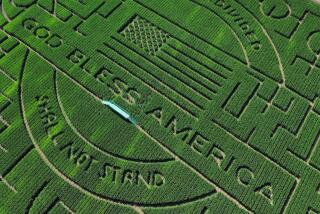As Far as Murals Go, This One Really Hams It Up
In St. Louis, it’s the Gateway Arch. In Seattle, it’s the Space Needle. In San Francisco, it’s the Golden Gate Bridge.
But in the city of Vernon (population 86), a tiny industrial hamlet bordering East Los Angeles, the reigning monument to Western culture is splashed across the sides of the Farmer John pork-packing plant on Vernon Avenue.
For the record:
12:00 a.m. Oct. 29, 1987 For the Record
Los Angeles Times Thursday October 29, 1987 Home Edition Part 1 Page 2 Column 6 Metro Desk 1 inches; 25 words Type of Material: Correction
In Tuesday’s editions, The Times incorrectly reported the number of pigs butchered each day at the Farmer John packing plant in Vernon. The plant actually handles 5,000 pigs a day.
It is a mural of pigs--maybe the biggest, gaudiest landscape ever painted on the walls of a slaughterhouse.
“Sometimes people drive around the block just to see all of it,” said Luis Rivas, 36, a butcher who has worked four years against its backdrop of roaming pigs and green fields. “Everybody who comes by looks at it.”
Between Vernon and L.A.
Indeed, the gigantic mural--at the boundary between Vernon and Los Angeles--dominates a city block, wrapping around the huge slaughterhouse on every side. The porcine panorama contains more than 200 pigs, emblazoned across 30-foot-high block walls, across a truck-loading dock, across the walls of the employee parking lot, across the reception counter inside the business office, even across a rear wall of the plant that forms one side of the Los Angeles River channel.
In a neighborhood of corrugated buildings, power lines and chain-link fences, the mural is like an unexpected bit of Hog Heaven--a touch of American Gothic, Vernon-style.
“It’s an impressive thing if you’ve never seen it,” said Farmer John sales manager Tom Clougherty, a member of the Clougherty family that founded the company in 1931.
Soon, however, what is now merely huge will be getting bigger. The plant, which butchers, cleans and packs 500 pigs a day, has just opened a new, 93,000-square-foot product distribution center, Clougherty said. That means all the more wall space for the sprawling artwork.
“We’re definitely going to maintain and expand it as we grow,” Clougherty said.
The task of painting the addition will soon fall to Arno Jordan, 53, an Austrian-born muralist who has been enlarging and retouching the pastoral scenery since the death of the original artist, Leslie Allen Grimes, in 1968.
Jordan, who has done smaller Farmer John landscapes in Phoenix, Tucson and Fresno, describes the Vernon project as his life’s crowning achievement--”the biggest mural I’ve ever seen anywhere,” he said.
“It’s like a landmark, in a sense--like the Watts Towers. . . .”
Mural Featured in Books
Magazines and travel books have featured the mural, which Grimes began in 1957. It has made the pages of Sunset magazine, the New York Times and the Times of London, which flew a reporter to America 10 years ago, Jordan said. He talks proudly of walking into a bookstore and finding the mural and his name in a book about street art.
At the same time, Jordan is modest about the mural’s artistic quality. It’s not the kind of thing one would paint on the Louvre.
“I’d put it into the primitive school, maybe Grandma Moses” style, he said. “It’s meant to attract attention. Maybe it looks good from a distance. . . . If you get real close you can see there really isn’t much detail.”
Jordan admits that the sky, in parts, is painted with rollers; the grass is done with another rudimentary technique, the paint being flung on a la Jackson Pollack. “I don’t even touch the wall with the brush,” he said.
Butchers and machine operators at the plant seem to spend little time assessing the cultural merits of the enormous painting. “I really don’t think about it,” said Daniel Creal, 24, a six-year employee. “People always wonder who painted it. I don’t think anyone knows, really.”
‘Makes the Place Stand Out’
Richard Romero, 26, a butcher, said the mural is one of two plant trademarks: “That and the smell. . . . It really makes the place stand out a lot.”
And while Romero said he has seen Jordan a couple of times, “I forgot his name.”
But such elusive recognition matters little to the artist.
“I’m not looking for fame at all,” Jordan said, declining to disclose what he is paid for the work. “I’m just happy with what I’m doing. I like the way it looks. If I had money, I’d do it for free.”
More to Read
Sign up for Essential California
The most important California stories and recommendations in your inbox every morning.
You may occasionally receive promotional content from the Los Angeles Times.










